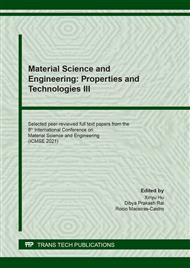p.37
p.43
p.53
p.59
p.67
p.73
p.81
p.89
p.95
Conductive Silicone Rubber Coated by Reduced Graphene Oxide Pseudo-Photonic Crystal Film
Abstract:
Graphene aqueous dispersion is difficult to be prepared as conductive film by simple solvent evaporation deposition, not only because of the agglomeration in its aqueous solution, but also caused by the “coffee ring” phenomenon during solvent evaporation process. Herein, as a derivative of graphene, graphene oxide (GO) would be used as film forming material due to its good dispersion in aqueous solution and its liquid crystallinity. If GO can self-assemble as a compact pseudo-photonic crystal film by solvent evaporation deposition, it will be converted into a conducive graphene film after thermal reduction. In order to prepare a flexible and conductive elastomer material covered with graphene film, compact GO pseudo-photonic crystal film can be transferred onto the surface of a 10% stretched silicone rubber plate. After releasing the stretched force, GO pseudo-photonic crystal film can form a lot of folds, which provide allowance of shrinkage for this GO pseudo-photonic crystal film to avoid cracking during the high temperature reduction. Benefiting from transferring the GO film onto a stretched silicone rubber, a flexible, colored and conductive graphene/SR can be obtained.
Info:
Periodical:
Pages:
67-72
Citation:
Online since:
March 2022
Authors:
Price:
Сopyright:
© 2022 Trans Tech Publications Ltd. All Rights Reserved
Share:
Citation:


